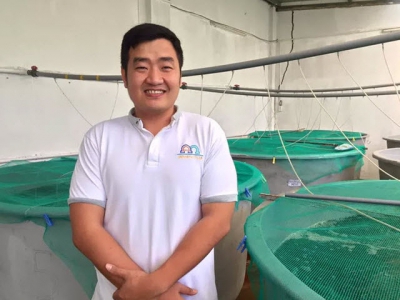The Loc star of shrimp health
Dr Loc Tran, founder of ShrimpVet and one of the key researchers behind the discovery of the causes of EMS in shrimp
 A plant-based solution to shrimp health
A plant-based solution to shrimp health A plant-based water conditioner that protects shrimp larvae and post-larvae against stress and health threats is now available in Mexico and Thailand.
 PCR testing of single-tissue samples can result in misleading data
PCR testing of single-tissue samples can result in misleading data Australian study looks at gill-associated virus (GAV) infection loads in shrimp
 Genomic breakthrough for freshwater prawns
Genomic breakthrough for freshwater prawns The sequencing and assembly of the world’s first high-quality genome of giant freshwater prawn (M. rosenbergii) has now been completed.
 A seismic shift in shrimp farming
A seismic shift in shrimp farming Charoen Pokphands Foods (CPF) has announced plans to stop farming shrimp in outdoor facilities within the next five years.
 Broodstock adds to RAS investments
Broodstock adds to RAS investments Seafood investor Broodstock Capital has acquired 50 perent of water treatment company NP Innovation, a leading supplier of water treatment technologies
 A progressive approach to shrimp health management
A progressive approach to shrimp health management How water quality management, low stocking densities and the use of specialised feeds can consign the use of antibiotics in shrimp farming to history.
 CENIACUA develops WSSV-resistant shrimp in Colombia
CENIACUA develops WSSV-resistant shrimp in Colombia White spot syndrome - white spot virus (WSSV) is the most pathogenic of all the serious diseases in the global shrimp industry.
 The unmet promise of pondside PCR
The unmet promise of pondside PCR Interest is high in aquaculture disease-diagnostics tools, but some say even the newest tech is too limited
 Low-salinity culture water controls Vibrios in shrimp postlarvae
Low-salinity culture water controls Vibrios in shrimp postlarvae Inland farms in southern Ecuador can produce up to 10 mt/ha of shrimp using underground water with 2- to 3-ppt salinity.
 Rising use of automatic feeders in shrimp ponds poses new feed requirements (Part 1)
Rising use of automatic feeders in shrimp ponds poses new feed requirements (Part 1) Although the cost of formulated aquafeeds in shrimp farming represents approximately 60 percent of the operating costs, the actual application and distribution
 Biofloc technology: Possible prevention for shrimp diseases
Biofloc technology: Possible prevention for shrimp diseases Live colony of macroaggregates and bacteria suspended in the water column can increase survival, feed conversion
 Origin of probiotics and efficacy of strains explored in shrimp focused study
Origin of probiotics and efficacy of strains explored in shrimp focused study Commercially produced probiotic strains may provide more support than those found indigenously, but indigenous strains may outperform the use of a non-supplemen
 Grain distillers dried yeast in practical diets for juvenile Pacific white shrimp
Grain distillers dried yeast in practical diets for juvenile Pacific white shrimp Feeds usually represent 40 to 60 percent of the total production costs in semi-intensive and intensive shrimp aquaculture, so reducing feed-related costs
 Evaluating commercial probiotic for juvenile Pacific white shrimp
Evaluating commercial probiotic for juvenile Pacific white shrimp Probiotics have been shown to change the intestinal microbiota by competing with pathogens for nutrients. Addition of probiotics to feed may therefore
 Advances in intensive copepod production technology
Advances in intensive copepod production technology The expansion of the marine aquaculture industry is currently limited, in part, by the inability to successfully bring large numbers of larvae through
 Ammonia toxicity degrades animal health, growth
Ammonia toxicity degrades animal health, growth An NH3-N concentration of 0.45 mg/L reduced the growth of five species of penaeid shrimp by about 50 percent.
 Shrimp necrosis has infectious etiology
Shrimp necrosis has infectious etiology Diseased shrimp exhibited skeletal muscle necrosis, indicated by the whitish discoloration of several abdominal segments.
 Automatic feeding in shrimp aquaculture
Automatic feeding in shrimp aquaculture As feed continues to represent the highest-cost input in aquaculture worldwide, the use of automatic feeders is proving to be an important approach to lowering
 Study: TSV exposure may lessen YHV effects in white shrimp
Study: TSV exposure may lessen YHV effects in white shrimp While testing indicated the shrimp were infected with the two viruses, TSV was restricted to the lymphoid organs. YHV was found in the cuticular epithelium
